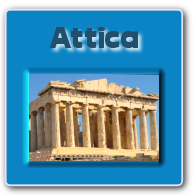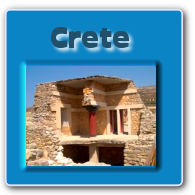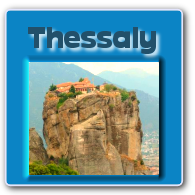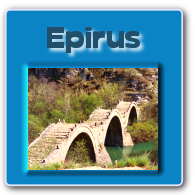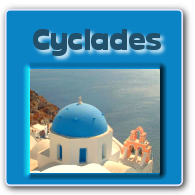Crete

Search hotel, city, region
Hotels

Rent a Car

Greek regions
- Aegean Islands
- Athens and Attica
- Central Greece
- Crete
- Cyclades
- Dodecanese
- Epirus
- Ionian Islands
- Macedonia
- Peloponnese
- Saronic islands
- Sporades
- Thessaly
- Thrace
Pictures of Greece
Greek links
Crete history
History of Crete
This island’s fertile soil and towering peaks witnessed the development of one of the most important civilizations on Earth, the Minoan (2800-1150 B.C.) In successive phase, the Minoans built palace states -the famous palatial centres of Knossos, Phaistos, Malia, Zakros (1700-1450 B.C.). The painters and ceramists show us the limits the refinement of art can reach. Their frescoes bring us close to the soul of that world, peace-Loving, light-hearted, but also powerful. They bring us close to the sea and its wealth. A geological catastrophe - the eruption of the volcano of Santorini in 1450 B.C.-halted the Minoan civilization at its height. But life did not cease. Through shipping, commerce and trade with other peoples -the Phoenicians, Syrians, Egyptians- new horizons opened up. With the invasion of the Archaians and the Dorians on the island the new cities of Lato and Aptera were founded. Lato became the most important city on Crete (7th century B.C.). Then the Roman occupation set in (69-330 A.D.). The most distinguished centre in those days was Gortyn. But Christianity came to the island early. During the Byzantine era the much coveted wealth of Crete was shown off in the mosaic floors of its basilicas and in half the churches of Greece. From the late 4th century until the mid-7th century, Crete was a prosperous and peaceful Byzantine province scattered with beautiful churches. However, Slavic invasions (7th century) and the island's subsequent conquest by the Arabs (828) came to disturb this peace. The Arabs founded their capital at Iraklion which they fortified and renamed (Handak).
The town was used by the Arabs as a base for their pirate raids in the Mediterranean until 961 when the Byzantines managed to resume control of the island. Handak, which became a flourishing commercial port, continued to be the islands capital and to develop. In 1204 Constantinople fell into the hands of crusaders and the Byzantine empire was divided among them. In 1211 the Venetians settled on the island. Through the centuries, the Venetian occupation was triggered numerous insurrections on the part of the Greek population attained a level of peaceful coexistence between the two peoples, further marked by mutual influences. Arts and literature flourished, the Cretan Renaissance (16th -17th century) transformed monasteries into spiritual and artistic centres which yielded religious icons and manuscripts that were channelled into the Orthodox East and Latin West. The towns became richer and more beautiful. Faced up against the Ottoman threat, the Venetians fortified the large centres and the coasts, however, they did not manage to prevent the conquest of Hania (1645) and subsequently that of Handak (1669). The island ultimately became a territory of the Ottoman Empire. In the late 19th century the incessant rebellions of the Greek populace drove the Great Forces to buttress the Greek struggle for independence. Crete was declared autonomous in 1898 and was incorporated into the Greek State in 1913.
Antiquities of Crete
District of Hania
Aptera. One of the most important cities of ancient (7th century B.C.) western Crete. Aptera was built on a site 15 km from Hania, south of Souda bay, near the village of Megala Horafia which has a view of the whole plain of Hania. The city walls still standing today are reminiscent of the Cyclopean walls of Tiryns and Mycenae. One can also see the remains of a small 1st century-B.C. temple of Demeter, a Roman theatre and the enormous vaulted cisterns of the Roman period - according to one source they ware used for grain storage - preserved in excellent condition. Phalassarna. (Falassarna This town, the port of Polyrrhenia, lay to the west of it, in the base of the extreme northwest peninsula of the district of Hania. The ruins remains of Cyclopean walls, tombs, house foundations, sculptures carved out of the rocks, most notably a throne are found near the village of Koutri. Polyrrhenia (Polirinia). The ruined walls and acropolis of Polyrrhenia lie 49 km west of Hania, near Selli or Paleokastro. Polyrrhenia, an important ancient western Cretan city, was founded with the help of the Archaeans, who succeeded, the Minoans as overlords of the island. At Kria Vrissi, near Kissamos (Kastelli), are the remains of a Roman aqueduct.
District of Rethymno
Armeni. A Minoan cemetery with tombs carved out of rocks has been unearthed.
Axos. Finds from a big Greek-Roman city. Eleftherna. Recent excavations held at the area brought to light monuments from a Greek-Roman city. Zominthos. A Minoan settlement has been discovered at the Nida plateau, 20 km from Anogia.
District of Iraklio

Agias Trias
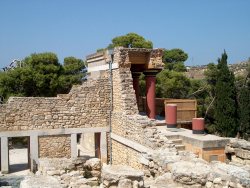
Knossos
Knossos. 5 km east of Iraklio. Inhabited since the Neolithic era. The first palace of Knossos was built around 1900 B.C. Two hundred years later it was destroyed by an earthquake and rebuilt, becoming grander and more luxurious. The final catastrophe occurred about 1500-1400 B.C., according to one theory, with the eruption of the volcano on Santorini. Despite this blow, people continued to live there for another fifty years, until a fire swept through the city circa 1400 B.C. The Minoan palaces ware not only the residence of the ruling house, they ware also administrative and religious centers for the whole region. The ruins of the capitalof the Minoan Kingdom include the palace of Minos, the homes of the officials and priests who surrounded him (Uttle Palace, Caravanserai, House of the Frescoes, etc.), the homes of ordinary people and the cemetery. The palace was a labyrinthine complex built around a central court. This multistoried construction covered an area of 22.000 m2 and, in addition to the royal quarters, also contained places of worship, treasuries, workshops and storerooms. Komos. The Minoan port of Phaistos. levina (lentas). Excavations brought to light a sanctuary of Asclepios and Minoan vaulted tombs. lyttos. Archaeological investigations uncovered finds from a big city of the Greek-Roman era. Malia. 34 km east of Iraklio and 3km beyond the summer resort of the same name. Excavations have brought to light a palace similar to the ones at Knossos, and Phaistos (also built around 1900 B.C. and abandoned about 1450 B.C.). At Hrissolakos (Pit of Gold), archaeologists also unearthed the districts surrounding the Minoan palace and cemetery. The palace covered an area of about 9.000 m2. Many of the objects now on display in Iraklio's Archaeological Museum ware found at Malia. Phaistos (Festos). 63 km southwest of Iraklio and about 78 km southeast of Rethymno, was the second most important palace-city of Minoan Crete. The residence of the mythical Radamanthes, the palace was also the nucleus of a settlement inhabited since the Neolithic age. The architectural layout is identical to that of Knossos. Here too the rooms are arranged around a court. On the other hand, in contrast to Knossos, the frescoes decorating the walls ware relatively scanty, the unpainted floors and walls being covered with a lining of pure white gypsum. The area of this palace was 9.000 m2. Tilissos. 14 km southwest of Iraklio lie the ruins of one of the oldest Minoan cities of central Crete, including three large buildings, residences of the local lords.
Vathipertro. 19 km south of Iraklio is where the ruins of a large Minoan mansion, a country estate belonging to a local nobleman, ware discovered. The ruins include a wine-press, olive press, weaving rooms and a possible potter's kiln.

Phaistos
District of Lassithi
Dreros (Driros). 16 km northwest of Agios Nikolaos. The archaeological site of this ancient Greek city comprises two acropolises with an Archaic agora between them. South of the agora is a temple from the Geometric period, the Delphinion, dedicated to Apollo, as well as a large cistern dug between the late 3rd and early 2nd century B.C.
Gournia. 19 km southeast of Agios Nikolaos, 15 km north of lerapetra, the best preserved of the Minoan settlements, and one of the most noteworthy archaeological sites in Crete. It appears to date from 1550-1450 B.C. The ruins of the town include small houses and a small palace on top of a hill; even the narrow streets and connecting stairways have survived amidst the foundations of the houses. ltanos (Ermoupoli). Finds from a big Greek-Roman city. Kato Zakros. 117 km southeast of Agios Nikolaos is the site of a luxurious Minoan palace, the fourth in significance on the island, which produced a number of important finds, in the Iraklio Archaeological Museum. This palace, which covered 7.000 to 8.000m2 and contained royal apartments, storerooms and various work-shops, and the nearby city ware destroyed around 1450 B.C. by a violent earthquake, most probably the one that caused a whole section of the island of Santorini to sink into the sea. Zakros was a major Minoan naval base, which established trading connections with Egypt and Anatolia. It was from here that Minoan farming estates, two sacred peaks, a cemetery and Gave tombs have been discovered. At Koufonissi. An islet in the south of the district, are the remains of a Greek-Roman city. Lato. 15 km west of Agios Nikolaos, Lato is spread out on the slopes of two acropolises. Founded in the 7th century B.C., it was one of the most powerful cities in Crete in its heyday. The ruins include the city walls, houses and shops from different periods built on terraces. Makrigialos. Finds from villas from the Minoan and Greek-Roman eras. Mirtos. Remains of Minoan settlements. Palekastro. 90 km east of Agios Nikolaos, 20 km from Sitia, at Roussolakos, has soma remains of a port settlement. Petras Ruins of a Minoan city. Psira Islet in the north of the district with ruins of a Minoan settlement.
Museums of Crete
District of Hania
Hania
Archaeological Museum Housed in the Venetian church of San Francesco. Its exhibits from western Crete and other areas date from the Neolithic to the Roman era, and include idols, statues, inscriptions, weapons, pottery, seal stones, coins, jewellery, etc.
Historical Archives of Crete. A rich collection of folklore and material related to the history of the island. Naval Museum of Crete. On the mole of the Venetian harbour. Exhibits linked with the island's history. Byzantine and post-Byzantine collection of Hania. The collection is housed in the Venetian church of San Salvatore.
District of Rethymno
Rethymno Archaeological Museum The Venetian loggia is a museum containing interesting archaeological finds from the region, as well as a fine coin collection.


Ethnological museum of Vori.
District of Iraklio
Archaeological Museum. One of the most important museums in Greece. Here are assembled almost all the find from the Minoan era. Pottery, stone carvings, seal stones, statuettes, gold, metalwork, the marvellous frescoes from the Royal and little Palaces and villas of the wealthy, and finally, the unique painted limestone sarcophagus from Agia Trias.
Historical Museum. Exhibits from, the Byzantine, Venetian and Turkish periods and historical documents of more recent Cretan history. Also a rich collection of folk art consisting of local costumes, textiles, wood carvings and embroidery as well as a representation of a typical Cretan house. Museum of the Battle of Crete and National Resistance. Natural History Museum. Archaeological Collection of Archanes Contains finds from the Malia palace, the Fourni cemetery, and the sanctuary at Anemospilia dating to the Minoan era. Museum of holy icons and relics of Saint Catherine.
Ethnological museum of Vori.
District of lassithi
Agios Nikolaos Archaeological Museum. It contains finds from excavations in eastern Crete.
lerapetra Archaeological Collection. Contains marble statues and inscriptions from the Greek-Roman era. Sitia Archaeological Museum. Contains finds from Sitia, Zakros, Petra and Paleokastro from the Minoan era.
Just



